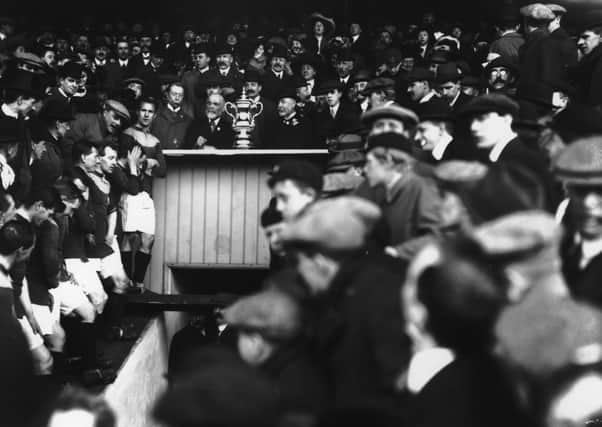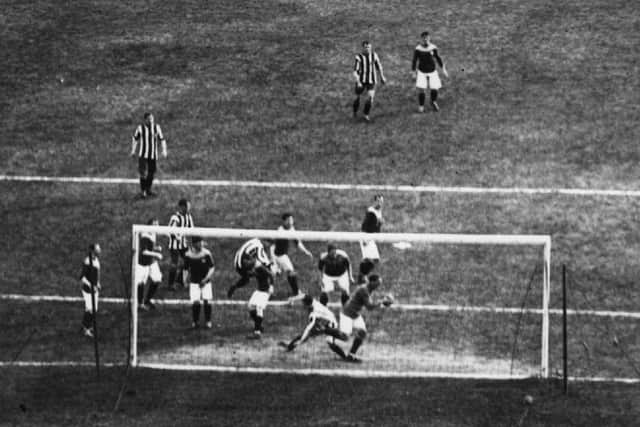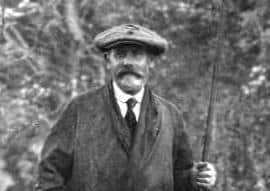Bygones – When the FA Cup made in Bradford returned to the city


Those were the words declared by the vice-president of the Football Association, Charles Crump, at Old Trafford 109 years ago as Bradford City beat Newcastle United 1-0 in the FA Cup final replay in what remains the club’s greatest achievement.
April 26, 1911 is one of the most significant dates in the club’s history as a goal from captain Jimmy Speirs was enough to clinch the Cup for City after the original final at Crystal Palace ended 0-0.
Advertisement
Hide AdAdvertisement
Hide AdThe first FA Cup final was played in 1872 but the original trophy was stolen from a Birmingham shop window in 1895 after Aston Villa had beaten West Bromwich Albion 1-0 in the final.
A replica was used for 15 years until a new design was created by Bradford-based jewellers Fattorini and Sons and hallmarked in Sheffield for the 1911 final, which was incredibly won by the Paraders, now more commonly nicknamed the Bantams.
Company owner Antonio Fattorini was a watchmaker, chess enthusiast, a well-known local sportsman and a timekeeper at the 1908 Olympics in London.
He was a founding member of Bradford City Association Football Club and was also a board member of the club when the FA Cup trophy was brought back to were it originated.
Advertisement
Hide AdAdvertisement
Hide AdFattorini served on the board at Manningham FC, a rugby club who occupied Valley Parade before it converted to association football as Bradford City AFC in 1903. The club had previously seceded from the Rugby Union and been the winners of the inaugural Northern Union championship. Fattorini had been present at the formation of the Northern Union in 1895 and his firm also designed the Challenge Cup of that code.


The first FA Cup trophy was made for £20 while Villa were fined £25 by the FA for the trophy being stolen while under their care. The FA commissioned a new trophy after the 1910 final as they did not own the copyright for the design of the original cup.
That is when Fattorini and Sons were tasked with designing a new trophy, the one that we are familiar with today. The Cup won by Bradford City was used for 81 years, until it was retired in 1992.
An exact replica of Fattorini’s design was made in 1992, in order to protect the original 1911 Cup and to allow fans more access to the new trophy, which was used for just 22 years before being replaced.
Advertisement
Hide AdAdvertisement
Hide AdIn 2014, a heavier version of the Cup, with the same dimensions and design, was introduced to make it sturdier against wear and tear.


In the 1911 final, Newcastle went into the game as the holders and the favourites after beating Barnsley to the trophy the previous year. After a 1-1 draw in the 1910 final, the Magpies won the replay 2-0 at Goodison Park.
Barnsley would win the cup in 1912, however, defeating West Brom 1-0 in a final replay at Bramall Lane. In 1911, Spiers’s winning goal at Old Trafford came 15 minutes into the contest as his header was fumbled into the net by the goalkeeper.
“It is my privilege to hand to Bradford City the Cup they have so well won today, after a strenuous struggle,” declared Crump.
Advertisement
Hide AdAdvertisement
Hide Ad“I consider it a very wonderful thing that the West Riding of Yorkshire, where Association football was scarcely known 10 years ago, should for two years in succession have a team in the final tie – a great testimony to the determination of the Yorkshire people.”
Newcastle had dominated the original final at Crystal Palace but were unable to make their possession count with the Paraders rarely troubled as the replay was taken to Old Trafford four days later. A total of 64 clubs entered the 1910-11 FA Cup as Bradford beat Gillingham, who were known as New Brompton at the time, 1-0 away from home in mid-January in the first round proper.
They met Norwich City at Valley Parade in the second round in early February, triumphing 2-1 before a third-round encounter with Grimsby Town followed at the end of February, a tie which Bradford edged 1-0. Another 1-0 success followed in the quarter-finals as City defeated Lancashire outfit Burnley.
That set up a semi-final tie with Blackburn Rovers on March 25, 1911 at Bramall Lane.
Advertisement
Hide AdAdvertisement
Hide AdBradford cruised to a 3-0 win and Newcastle defeated Chelsea by the same scoreline at St Andrew’s. The imagination of the Bradford public was captured in the weeks leading up to the final and it remains City’s only appearance in an FA Cup final.
Several large companies across Bradford closed to allow their employees to make the trip to Crystal Palace, with 69,068 fans packed in to witness the match. The replay was just as well attended as 66,646 supporters made their way into Old Trafford to watch Speirs etch his name into Bradford legend.
The Paraders’ triumph was built on defensive solidity as they conceded only one goal throughout their entire Cup run.
That came in their second-round win against Norwich, meaning their defence was breached just once in 630 minutes of action.
Advertisement
Hide AdAdvertisement
Hide AdKeeping Newcastle at bay for two matches was all the more impressive, considering the north-east outfit had netted 18 goals en route to the final compared to City’s eight.
Both clubs were in the First Division, with Bradford City earning their highest finish of fifth during in the 1910-11 campaign.
They won the Division Two title in 1907-08 and with it promotion to Division One and narrowly avoided relegation in their first top-flight campaign. Bradford City and Newcastle met twice in league competition in 1910-11.
The beaten FA Cup finalists won 6-1 at St James Park in December but Bradford won the reverse 1-0 at Valley Parade just two weeks before the first final at Crystal Palace.
A real physiological boost if ever there was one.
Advertisement
Hide AdAdvertisement
Hide AdIn the Bradford City official programme, the West Yorkshire club was described as “playing dashing football in all departments” in the replay at Old Trafford as the City team were welcomed as heroes on their return to Bradford.
They were given a civic reception by the Lord Mayor of Bradford, Mr Jacob Moser, and were cheered through the densely-packed streets by delighted supporters, it was claimed that as many as a hundred thousand people greeted the victorious team.
Bradford got the defence of their trophy off to an ideal start in 1912, winning a first-round replay 4-0 against Queens Park Rangers at Valley Parade.
A 2-0 home win over Chelsea followed before they defeated rivals Bradford Park Avenue at Valley Parade in the third round.
Advertisement
Hide AdAdvertisement
Hide AdThey met Barnsley in the fourth round, with the match played three times after the first two meetings ended 0-0.
The second replay and third meeting at Bramall Lane turned out to be a five-goal thriller and although Bradford City were beaten 3-2, Barnsley made sure the trophy was kept in its home county with a dramatic 1-0 extra-time victory over West Brom in a final replay in Sheffield.
Editor’s note: First and foremost - and rarely have I written down these words with more sincerity - I hope this finds you well.
Almost certainly you are here because you value the quality and the integrity of the journalism produced by The Yorkshire Post’s journalists - almost all of which live alongside you in Yorkshire, spending the wages they earn with Yorkshire businesses - who last year took this title to the industry watchdog’s Most Trusted Newspaper in Britain accolade.
Advertisement
Hide AdAdvertisement
Hide AdAnd that is why I must make an urgent request of you: as advertising revenue declines, your support becomes evermore crucial to the maintenance of the journalistic standards expected of The Yorkshire Post. If you can, safely, please buy a paper or take up a subscription. We want to continue to make you proud of Yorkshire’s National Newspaper but we are going to need your help.
Postal subscription copies can be ordered by calling 0330 4030066 or by emailing [email protected]. Vouchers, to be exchanged at retail sales outlets - our newsagents need you, too - can be subscribed to by contacting subscriptions on 0330 1235950 or by visiting www.localsubsplus.co.uk where you should select The Yorkshire Post from the list of titles available.
If you want to help right now, download our tablet app from the App / Play Stores. Every contribution you make helps to provide this county with the best regional journalism in the country.
Sincerely. Thank you. James Mitchinson, Editor
Comment Guidelines
National World encourages reader discussion on our stories. User feedback, insights and back-and-forth exchanges add a rich layer of context to reporting. Please review our Community Guidelines before commenting.